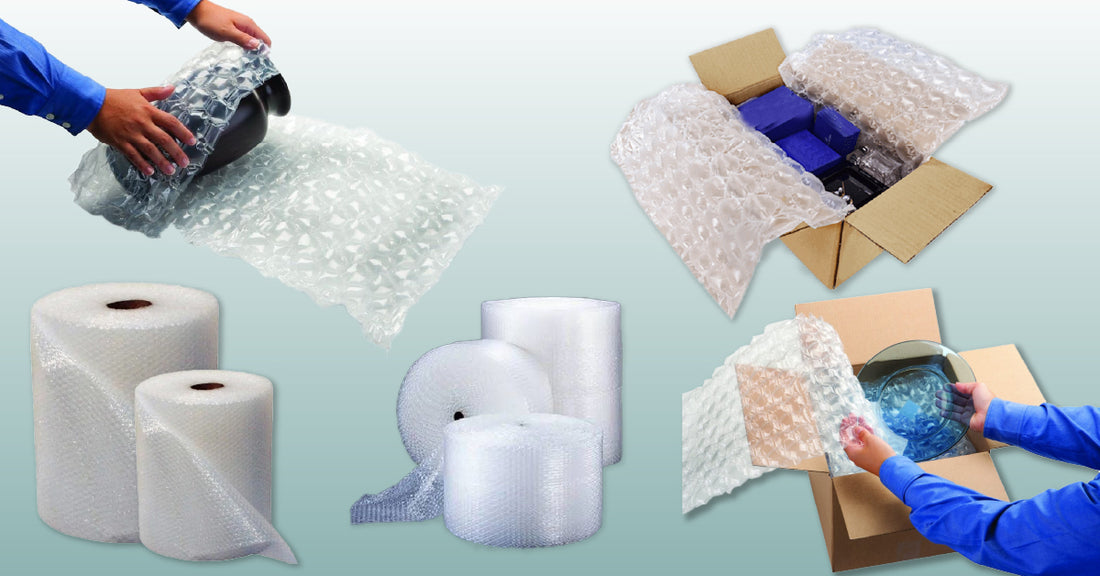Bubble wrap has many great uses; including house moving, storage and shipping. It is a form of protective packaging, made up of hundreds and thousands of tiny air bubbles that work together to absorb shock from knocks and bumps so that the items they are wrapped around do not feel a thing. When you buy bubble wrap, it can protect from knocks but also from scratches and water damage too, because the material that surrounds the air bubbles is fully waterproof too. This is especially important if it rains, which it does a lot in the UK.

So what are the different types of bubble wrap and what are their uses?
-
Small bubble wrap for packing is the regular and most common form of bubble wrap. It is highly versatile and can be used for almost anything. The smaller size air bubbles can fit around almost any object and if you need additional protection of a large and heavy object then you can use multiple layers to achieve extra cushioning. It is excellent value for money as it is the most popular and mass produced type of bubble wrap. You can buy it from multiple retailers and online is always the best price. It is recyclable too, so if you can’t re use it, make sure you recycle it.
-
Large bubble wrap is made up of larger air bubbles. The larger air bubbles provide more cushioning because of their size, so these are designed for protecting larger and heavier items from damage. The large size of the bubbles means they are less practical for smaller objects, but they are great for protecting bigger things. Large bubble wrap is more expensive than smaller bubble wrap, and it can be harder to buy because not many retailers offer it. So make sure you buy from a specialist online retailer. Again, it is recyclable too, so if you cannot re use it, then recycle it.
-
Paper bubble wrap is the most environmentally friendly option and type of bubble wrap. It is a fairly new conception which was first brought to market in 2020. It is made from cardboard / paper, and it has bubbly contours which give the same effect as bubble wrap. It is not quite as effective with protection as normal bubble wrap however, but is fine for light objects and is definitely worth the consideration due to its environmental benefit.
Why was bubble wrap first invented?
-
Bubble wrap packaging was not first intended for protection purposes.
-
It was first invented as wallpaper in America! The trend did not exactly take off, but it didn’t take long for people to realise the protective benefits of the wallpaper made from air bubbles.
-
Soon people started wrapping it around objects they were shipping and moving, until eventually it was picked up by the global packaging industry and used for protection.
What alternative protective packaging is available?
-
Packing tissue paper is another important form of protective packaging. It is great for protecting glasses and ornaments and delicate items from the kitchen, because it is soft enough to protect from scratches. You can roll it up and stuff it inside of glasses which provides extra strength for the glasses from within, and then wrap it around the object too.
-
This can be used with or without bubble wrap too. Bubble wrap is widely considered the best type of protection for any size objects.
-
Cling film is another form of protective packaging which is used to wrap around cardboard boxes when they are full. Another name for this is stretch wrap. It protects from water damage, so if it rains during transit, you know the contents of your boxes will be safe.
-
Packing paper is also often used for protection. It is a large and thick sheet of paper, much like wrapping paper, which is used as a gentle layer of protection around small objects. It really only protects the outside of a parcel from marks.
-
Out of all the types of protective packaging, the best bubble wrap for moving is always the best option as it is the safest, most reliable option. It is also the best value for money of all the types of protective packaging too, so if you are moving house then it is always good to save money.





